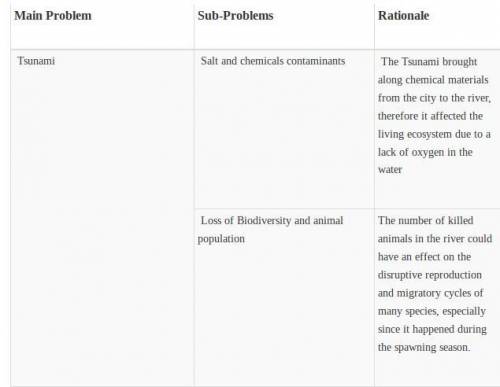
Biology, 13.11.2020 03:10, kdcloyd88191
Recovering Ecosystems Worksheet Section 1: Select the Kitakami River region, the Abukuma Highlands, or Japan's coastal habitat as the ecosystem you want to help with recovery. List the main problem faced by this ecosystem as described in the lesson. Then list at least two sub-problems that need to be considered to solve the main problem. List the sub-problems in order of most to least important. In the rationale column, explain why you placed your sub-problems in the order you selected. Main Problem Sub-Problems Rationale Section 2: Conduct internet research on your selected ecosystem to help you generate a list of three criteria and two constraints. Your criteria and constraints should consider relevant factors to the problem, such as costs, reliability, safety (to humans and wildlife), human needs, environmental impact, local biodiversity, and the aesthetics of the area. List the criteria in order of most to least important and assign each to a related sub-problem. In the rationale column, explain why you placed your criteria in the order you selected. Constraints Criteria Rationale Which Sub-Problems does this criteria address? Section 3: For at least one of the sub-problems, propose two solutions based on the information from the lesson and your additional research. In the rationale column, explain how your solution restores the stability and biodiversity of your selected ecosystem. Sub-Problem Proposed Solutions Rationale Section 4: Answer the following analysis questions about your proposed solutions. Describe the ways your proposed solutions decrease the negative effects of habitat destruction and human activity on your selected ecosystem. Describe the costs, safety, and reliability of your proposed solutions, as well as any social, cultural, and environmental impacts your solutions address. Evaluate your proposed solutions for their impact on overall environmental stability and changes. Which solution has more impact? Explain your reasoning for picking one solution over another. How could you refine one of your proposed solutions to further reduce environmental impact and loss of biodiversity while also addressing human needs?

Answers: 3
Other questions on the subject: Biology

Biology, 22.06.2019 07:00, rebekahhenton
The is an estimate of the fewest number of organisms a population needs to avoid extinction. this measurement will most if the number of offspring each female in the population produces increases. if the population's this measurement will most likely increase. 1 population density, minimum viable population, carrying capacity 2 decrease, be unaffected, increase 3 death rate increase, dead rate decrease
Answers: 2

Biology, 22.06.2019 17:30, linshweyioo5442
Ms. w, a 21-year-old woman, came into a clinic after suffering a deep laceration on her foot while walking barefoot around her yard. the wound was cleaned, sutured, and bandaged, and she was released to return home after receiving tetanus antitoxoid. within 72 hours, the wound area was red and swollen, the suture line was dark in color, and it was accompanied by severe throbbing pain. ms. w had a high fever, her heart felt like it was racing, and she was finding it hard to concentraten even on simple tasks. she returned to the clinic and was immediately taken to the hospital. following lab tests, a diagnosis of acute necrotizing fasciitis was made. discussion questions 1. explain why ms. w. received a tetanus antitoxoid before leaving the hospital. (see chapters 3 and 4, infection and passive immunity.) 2. explain how acute necrotizing fasciitis developed in this case and the pathophysiology involved. (see acute necrotizing fasciitis.) 3. what is the potential outcome for ms. w if antibiotic drugs do not reduce the infection quickly?
Answers: 3

Do you know the correct answer?
Recovering Ecosystems Worksheet Section 1: Select the Kitakami River region, the Abukuma Highlands,...
Questions in other subjects:


English, 01.08.2019 09:10

Mathematics, 01.08.2019 09:10

History, 01.08.2019 09:10

Mathematics, 01.08.2019 09:10





History, 01.08.2019 09:10







